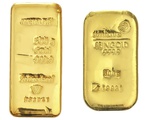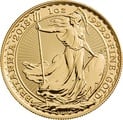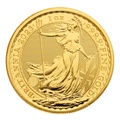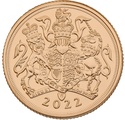How to tell if gold is real
For as long as gold has been part of human culture it has been valuable and highly sought after, and as such there have always been those who have tried to make it themselves through counterfeiting. To avoid the risk of spending your money on something that is not real, we’d recommend you always buy your gold and silver bullion from a reputable dealer like BullionByPost. Our gold bullion bars are manufactured by LBMA-approved refiners and our coins are checked thoroughly for their weight, metal, and authenticity, and we can can therefore assure you that the gold you are buying is real.
Jewellery is often one of the most common targets for fake gold, but counterfeit bullion does also exist, and it is possible that at some point you may come across it if buying from private sellers, or unscrupulous dealers. Knowing how to tell if gold is real could save you a lot of hassle and, most importantly - money. Luckily, due to gold’s unique properties, accurate fakes are incredibly difficult to make and there are a few easy tests you can do at home to tell if your gold is real.
Learn more about
why you should buy from BullionByPost.
1 - Test its size and weight
This test applies primarily to bullion coins and simply involves checking the size and weight of your coin. Bullion coins are made to a set of specifications, giving you a reference point to test the authenticity of your gold. Gold is one of the densest metals on the planet, with physical properties that are incredibly hard to replicate. This means that any metal used to copy a gold coin will likely be much less compact, and it would take more of it to replicate a certain weight of gold.
A fake one ounce Britannia, for example, would therefore need to be wider and/ or thicker to match the weight of a real one. Similarly, a fake gold Britannia with the same thickness and diameter as a real one would be noticeably lighter. Knowing the specified weight, diameter, and thickness of your gold coins will allow you to easily identify a fake.
2 - Magnet test
This is another very easy test you can carry out at home with minimal equipment needed. Unlike most metals, gold is not magnetic and a real gold bullion coin, bar, or piece of jewellery will not stick to a magnet. You can try this at home with any reasonably strong magnet.
Try to pick your gold coin up with a magnet. If you are able to, you know that your coin, bar, or jewellery is made from, or at least contains, one or several other metals. Care should be taken with this method, however, as gold is not the only non-magnetic metal and a fake coin could well pass this test.
Conversely, it is always important to bear in mind the purity of the gold you are testing. Most bullion coins and bars are pure 999.9 gold, and should therefore not be magnetic. There are some coins however - such as the gold Sovereign - that have a purity of 916.7 per tradition. The introduction of other metals in these coins could mean the coin is magnetic. Jewellery is almost always a gold alloy rather than being pure, so they could contain much more of other metals than gold.
We therefore recommend that you use the magnet test alongside one or several of the other tests mentioned in this article to be sure, and take any findings only as an initial guide.
3 - Testing gold by its sound
The ‘ping’ test, as this is commonly known, allows us to tell if a coin is made from real or fake gold by listening to the sound it makes when struck. Precious metals will make a long, high-pitched ringing sound when struck as opposed to base metals, whose respective sounds will be duller and much shorter. Balancing your coin on the end of your finger and tapping it with another coin should make a ringing sound, and the difference between a coin made from pure gold and one made from a non-precious metal should be obvious.
4 - Ceramic test
Dragging your gold over a ceramic plate is another quick and uncomplicated way to test your gold. Simply draw your gold across an unglazed ceramic plate, applying slight pressure. If you can see a gold mark on the ceramic once you’ve done this, then the gold is real. However if the mark is black then it is fake.
5 - Nitric Acid Test
The least straightforward of these tests, partly because you risk doing permanent damage to your metal in doing so unless, of course, it is pure gold. The premise idea behind this test is that gold is resistant to oxidation and corrosion and so pure gold will not be affected by the acid. Different strengths of acid are available to test different carats, so gold that doesn’t react to the acid is at least as pure as the carat rating suggested, if not higher. Conversely, if you apply acid marked for 22 carat gold to your 24 carat bar, you know that your gold is at best 22 carat gold, and maybe not gold at all.
There are plenty of other ways to tell if your gold is real. In the case of jewellery, you would notice fake gold leaving a mark on your skin the longer you wear it. Biting down on gold is an old favourite - the softness of 24 carat gold means that your teeth would leave slight marks. Of course, this isn’t the safest or most accurate method and we certainly wouldn’t recommend it.
Indeed, the best way to know if your gold is real is to leave yourself with no doubt in the first place, by buying from a reputable dealer such as BullionByPost. We buy our gold from LBMA-approved refiners, or in the case of second hand items being bought back from customer, we test them using an
XRF machine.
These machines offer a much more accurate, non-destructive way for us to test the authenticity and purity of any metal, in a quick simple way.
- How To Buy Gold
- How to Buy?
- Payment Options
- Delivery Options
- Gold Storage
- Storage at Brink's
- Gold Investment Guide
- Why buy gold?
- Is gold a good investment?
- Why physical gold?
- Best time to buy gold?
- Gold bars vs coins?
- Gold vs Silver
- Gold - Silver Ratio explained
- VAT on bullion
- CGT on bullion
- Legal tender coins
- Top 5 Gold Investments
- Top 5 Silver Investments
- Gold vs ISAs
- Gold vs Buy-to-Let
- Gold vs FTSE 100
- Gold vs Bitcoin
- Where to buy gold?
- Why buy from us?
- Where to sell gold?
- Coin Shops
- Gold Price Forecasts
- Top 10 Gold Producers
- Top 10 Gold Reserves
- Gold Britannia vs Sovereign
- Britannia coin designs
- Sovereign coin designs
- Sovereign Mintages
- Sovereign mint marks
- British coin specs
- What is a proof coin?
- Royal Mint bullion
- The Queen's Beasts
- Royal Mint Lunar Coins
- Bullion Refiners
- British coin mints
- Krugerrands
- Gold Tola - India & Pakistan
- Bullion Index











